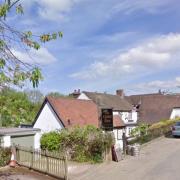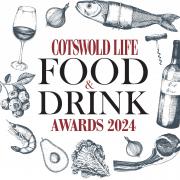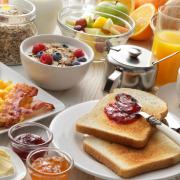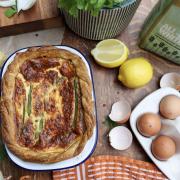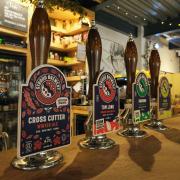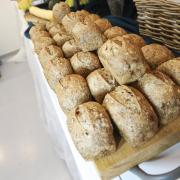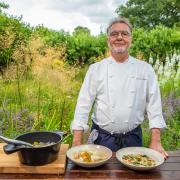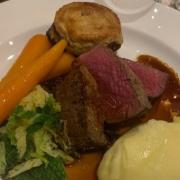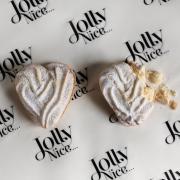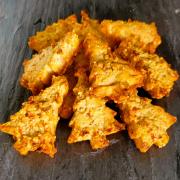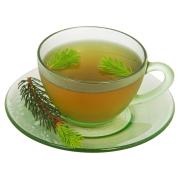By Alison Hall Jonathan Crump’s unique farm at Standish – with its pedigree herd of Gloucester cattle and Jacob sheep – is keeping Cotswold traditions alive. He talks about his mouth-watering creations, and how the farm’s produce is diversifying
This May, when hundreds of people gather for Randwick’s famous Wap festival, they will see wheels of Double Gloucester cheese being rolled down a hill in the village. It’s a tradition that dates back to medieval times. The previous Sunday, the same wheels will have been rolled around the parish church three times as well. But what makes this quirky annual event even more remarkable is that these cheeses, made at a neighbouring farm, are the only ones in the world made exclusively from the milk of Gloucester cows.
On a lovely late summer’s evening, my husband Chris and I took the pleasant mile’s walk from Randwick, through the woods, to meet Jonathan Crump, long-time tenant farmer of Standish Park Farm. As we approached across the fields, the distant views towards the Severn and beyond were stunning. Closer at hand, crinkly contours of pasture and rich hedgerow were golden in the evening light, and a few of Jonathan’s many rare breed sheep looked up and surveyed us quizzically as we passed. This is natural, wildlife-friendly permanent pasture: the Crumps use no artificial fertilisers or chemicals, preferring to stick with good old-fashioned manure.

We caught up with Jonathan, sustainable farmer, rare breed specialist and artisan cheesemaker, as he called in his pedigree herd of Gloucester cattle for their evening milking. After pausing at the large pond – another haven for wildlife – to spot dabchicks and moorhens, we followed the 20 or so Gloucester ladies as they made their dignified progress up the path to the milking parlour, where they filed in calmly and awaited their turn. Their milk will go to make the traditional, unpasteurised Double and Single Gloucester cheeses that Jonathan has been making for 25 years and that have won many prizes. As the cows took their places in the small and traditional milking parlour, several at a time, and the milking machinery clanked and whirred around us, we talked about these fine animals and their local history.
I must say a word about their appearance. These Gloucesters are beautiful animals, and describing them is like describing a Dior outfit on the cat-walk: an elegant and well -proportioned body of dark mahogany is matched with striking black heads and legs, while the breed’s stylish and characteristic white stripe passes down the back and down, around the body. The whole look is completed by a set of glorious, up-swept horns. As representatives of one of the oldest dairy breeds in the country, as well as one of the rarest, with a history stretching back to the 13th century – accustomed to accolades at The Three Counties Royal Show and to the attentions of BBC and Channel 4 television cameras – these ladies are aristocrats. It is as if they remember that one of their breed, Blossom, famously helped Edward Jenner as he developed the first vaccine against smallpox.

Jonathan explained that things looked different in the early 1970s, when the Gloucester breed came perilously close to disappearing altogether. An ever-increasing focus on high milk yields and other changes in farming practices pushed this venerable but relatively low-yielding breed out of fashion. Some survived, but few substantial herds remained, and when one of the last, at Wick Court, Arlingham, went to dispersal sale in 1972, the prospects looked bleak. Fortunately, a small group of enthusiasts in rare breed conservation and Gloucestershire heritage and history – including Charles Martell of Dymock, and Joe Henson (father of Adam) – rallied round to keep the breed alive and the recovery began. In 1974, classes for Gloucesters appeared at the Three Counties Show for the first time in decades. They have appeared there ever since, and for many years have included cattle from Jonathan’s herd.
Jonathan has a deep interest in rare breeds and conservation as any visitor to Standish Park Farm will quickly see. Building on the work done back in the early 1970s, he has been breeding pedigree Gloucesters for 30 years, having acquired his first Gloucester cow back in his distant days of working at Hungerford Rare Breeds Farm. He has built up a herd of around 80, including calves and 30 breeding cows. It is a labour of love, but it is easy to see why these beautiful animals have captured a place in his heart. They all have their own names and temperaments, and their place in the strict bovine pecking-order. Jonathan tells me that they are generally docile and quiet animals (despite the formidable horns!) and always popular with the public at shows.
While cheese is Jonathan’s main product, the herd also supplies a modest amount of Gloucester beef. Known to be tender and well-flavoured, Gloucester beef is much in demand, particularly in an environment when customers appreciate beef that has been reared to very high welfare and environmental standards. This most versatile breed has a further traditional skill. When a bovine odd-man-out called Bill puts in a brief appearance in the milking parlour, Jonathan explains that he has been training Bill and his fellow-bullock, Ben, as draught oxen. Jonathan remembers being impressed by draught oxen he saw in the USA while on an exchange from Cotswold Farm Park to a museum in Virginia, where their fully trained oxen would respond to voice command alone and without a halter. He hopes that, with time, Bill and Ben will do the same. For now, Bill is just anxious to depart from the milking parlour and does so at the first opportunity. The cows are all bigger than he is, and Bill is under no illusions as to his place in the pecking order. It was time for us to make tracks, too. Dusk was gathering, and we had to head for home before the light failed. As a final question, I asked Jonathan what was his favourite part of the working day. He replied without hesitation: ‘Milking these cows.’

When Chris and I next trek up the hill from Randwick and back down to beautiful Standish Park Farm, all is calm around the milking parlour. When last we arrived here, there had been a flurry of excitement: one of Jonathan’s sons was hurrying off on a quad bike in pursuit of a couple of errant rams. The aim was to round up the rams before they could find the ewes and do what rams do best… weeks too early. Today, the Gloucester cattle line up for milking, each one choosing her favourite stall. As the cows settle in to enjoy a snack from buckets of feed, and the sweet milk flows, we chat to Jonathan about turning the creamy liquid into cheese.
We half-expect to hear of a mystical practice, perhaps passed down through the generations. Not a bit of it: Jonathan is matter-of-fact on the process of producing the cheeses, something that he does on the farm twice weekly in winter and three times in summer. Not from cheese-making stock himself, he learned the skill as an adult, and it is a traditional process undertaken with care rather than a mystical one. Proud as he rightly is of his delicious Double and Single Gloucester cheeses, it is the Gloucester cattle themselves, rather than the cheese made exclusively from their milk, that Jonathan loves best. Quoting his friend and mentor, Charles Martell, he tells me that ‘good milk makes good cheese’. (And if I may wax a little lyrical here, I do feel that the essence of the flower-filled meadow grass comes through in the fresh-tasting and buttery Crump Single Gloucester, and the firm and fragrant Double Gloucester.)

We ask (as everyone asks) about the difference between Single Gloucester and Double Gloucester cheeses. Jonathan explains that we are all used to seeing ‘Double Gloucester’ of some sort in every supermarket: anyone can call a cheese Double Gloucester. The term ‘Single Gloucester’, however, now has a ‘Protected Designation of Origin’ (PDO) that limits its use. Crump Single Gloucester goes above and beyond these PDO requirements, coming as it does exclusively from unpasteurised Old Gloucester milk, as does Crump Double Gloucester (good milk makes good cheese!). The Double is a denser texture than the Single, is matured for longer (four or five months instead of two or three) and takes its characteristic colouring from annatto. In terms of selling his cheese, Jonathan’s only problem is keeping up with demand. Production levels are naturally limited by the output of his Old Gloucester milking herd, and almost all their milk goes for cheese already. Most of his cheese is sold locally, which is just as Jonathan likes it. This is true artisan cheese-making; it’s not an industrial process that can be scaled up at the click of a mouse. I suspect that this is just as Jonathan likes it, too.
In recent years, Jonathan and Annabelle have turned their talents to keeping another Gloucestershire tradition alive and involves not their cows, but Jacob sheep. There is good news, Jonathan tells us: blankets and shawls made exclusively from wool from his handsome rare breed Jacobs are due before Christmas, in time for the legendary Christmas bazaar in St John the Baptist Church, Randwick. It has been quite a journey. First, Jonathan shears the Jacobs and family Crump goes to work in the barn, separating the light and dark fleece by hand – the colours will later be recombined in attractive woven patterns. The wool – half a tonne of it – then heads to Yorkshire for scouring and spinning, then to Langholm in Scotland to be woven, and then to Galashiels to be finished. Finally, the blankets and shawls come home to Standish Park Farm, where Annabelle sews on the ‘Standish Woollens’ labels by hand. It is a painstaking and labour-intensive business, and the financial outlay is substantial, but the blankets and shawls will be things of beauty, beautifully crafted. Using the wool in the traditional way is important to Jonathan. As he sees it, that is the right thing to do with the it, just as making Single and Double Gloucester cheese is the right thing to do with the Gloucester milk.
Milking is over, and a 28-year-old donkey called Ernie now appears in the milking parlour. He investigates one of the abandoned grain buckets, finds he is in luck and promptly kicks the bucket over. The spilled grain attracts the attention of Jocelyn (pedigree name ‘Princess Joan’,) one of Jonathan’s magnificent Old Spot sows. Jocelyn has left her piglets in the care of the farm dogs, who look disconcerted at their new responsibilities. Jonathan explains that the dogs find the piglets fascinating, but they don’t know quite what to make of them.

Jocelyn, meanwhile, takes her time with the grain before returning, stately as a galleon, to her nursery duties. If she shares Jonathan’s disappointment at four piglets instead of the hoped-for ten, she is too regal to show it. An Old Spot sow takes a lot of feeding, Jonathan explains, ruefully, and a large litter helps her to earn her keep. Jocelyn’s offspring, meanwhile, more than make up for in cuteness what they lack in numbers. The Old Spots, young and old, love the whey left after cheese making. As Jonathan explains, the breed has its origins in the Severn and Berkeley vales, and whey from the local Gloucestershire cheeses was what they liked, then and now.
As so often, we need only look to the past for the best idea about sustainable practices. Chris and I must head back through the Randwick woods in their glorious late autumn colours. Before we go, I ask for an update on the escaped-ram saga from our last visit. Jonathan reports that all was well, that the rams are now happily out among the ewes (with his blessing) and that the first lambs should arrive as per timetable. And, so, the farming year goes round in this beautiful place, and the Crumps’ vision for a natural and sustainable future continues to flourish.
You can find Jonathan Crump cheeses and Standish Woollens blankets and shawls at Stroud Farmers’ Market on the first and third Saturday of the month. The cheeses are also available from a number of farm shops and specialist cheese shops, mostly within Gloucestershire. But you need to be quick – his cheese does fly off the shelves. jonathancrumpsgloucestercheeses.co.uk
Alison is co-editor of the Randwick Runner, thought to be Britain’s longest-running weekly village newsletter.




